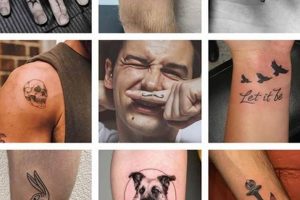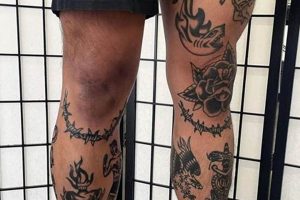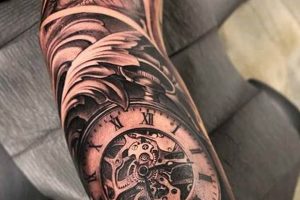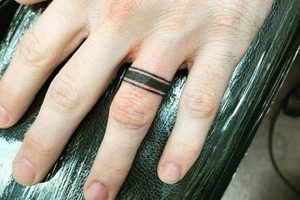The forearm presents a prominent canvas for body art, offering ample space for diverse designs and styles. Examples range from intricate, full-sleeve concepts incorporating elements like nature scenes, geometric patterns, or portraits, to smaller, standalone pieces such as symbolic imagery, script, or abstract art.
Choosing this location provides several advantages. Visibility allows for personal expression and easy showcasing of artwork. The forearm’s muscular structure can also enhance the visual impact of certain designs. Historically, arm tattoos have signified various cultural affiliations, spiritual beliefs, or personal narratives, adding a layer of depth and meaning beyond mere aesthetics. This enduring practice continues to evolve, influenced by contemporary art, technology, and individual preferences.
Exploring potential designs requires consideration of factors like personal style, pain tolerance, and the desired level of commitment. Elements such as size, color palette, and the chosen artist’s expertise all contribute to the final outcome. The following sections delve into popular stylistic choices, practical advice for selecting an artist, and essential aftercare instructions.
Tips for Forearm Tattoo Selection and Process
Careful planning ensures a successful tattoo experience. Consider these factors before committing to a design and artist.
Tip 1: Research Styles Thoroughly: Explore various tattoo styles (e.g., realism, traditional, tribal, geometric) to determine which best reflects personal aesthetics and the desired imagery.
Tip 2: Consider Size and Placement: Forearm tattoos can range from small, discrete designs to large, intricate pieces. Placement choices include the inner forearm, outer forearm, and wrapping around the entire arm. Visualize the final look and its impact on overall appearance.
Tip 3: Choose a Reputable Artist: Research artists specializing in the chosen style. Review portfolios, check client testimonials, and ensure adherence to hygiene standards.
Tip 4: Plan for the Long Term: Tattoos are a significant commitment. Consider the design’s relevance over time and its potential impact on professional life.
Tip 5: Communicate Effectively: Clearly articulate design preferences and expectations to the chosen artist. Open communication is crucial for achieving a satisfactory outcome.
Tip 6: Prepare for the Process: Follow pre-appointment instructions provided by the artist, such as avoiding alcohol and caffeine. Ensure adequate rest and hydration.
Tip 7: Prioritize Aftercare: Proper aftercare is essential for healing and preserving the tattoo’s vibrancy. Follow the artist’s instructions diligently.
Following these guidelines significantly increases the likelihood of a positive and fulfilling tattoo experience, resulting in a piece of body art that provides lasting enjoyment and personal significance.
By approaching the process with thoughtful preparation, individuals can confidently embark on their tattoo journey and create a meaningful addition to their personal narrative.
1. Theme
Theme selection acts as the foundational element in forearm tattoo design, profoundly influencing the final aesthetic and symbolic meaning. A clearly defined theme provides a cohesive narrative, unifying various design elements into a harmonious whole. This thematic coherence allows for deeper personal expression, transforming body art into a powerful storytelling medium. For example, a theme of mythology might incorporate specific deities, creatures, or symbolic imagery relevant to the chosen mythology, resulting in a cohesive and meaningful design. Alternatively, a nature-inspired theme could feature interconnected elements like flora, fauna, and landscapes, reflecting a reverence for the natural world.
Thematic resonance enhances the impact of a tattoo, moving beyond mere aesthetics to convey personal values, beliefs, and experiences. A chosen theme informs stylistic choices, color palettes, and overall composition, creating a unified artistic expression. Careful thematic planning also ensures the tattoo remains relevant and meaningful over time. For instance, a theme centered on personal growth could incorporate symbols of transformation, resilience, or new beginnings, acting as a permanent reminder of one’s journey. Similarly, a tribute to family might include birthdates, portraits, or symbolic representations of familial bonds, expressing enduring love and connection.
Successful tattoo design relies heavily on a well-defined theme, providing a conceptual framework that guides artistic choices and imbues the final piece with lasting significance. Consideration of personal values, interests, and long-term relevance ensures a meaningful and impactful addition to one’s personal narrative, transforming a simple design into a powerful statement of self-expression.
2. Placement
Placement is a critical factor in forearm tattoo design, impacting both aesthetic appeal and practical considerations. The forearm offers distinct zonesinner, outer, and topeach presenting unique characteristics that influence design choices. The inner forearm, generally less exposed to sunlight, offers better ink longevity and provides a more discreet option. Its relatively flat surface lends itself well to intricate details and text-based designs. The outer forearm, more visible and susceptible to sun exposure, provides a bolder canvas for showcasing artwork. Its curvature can be incorporated into designs, creating dynamic visual effects. The top of the forearm presents a less common but increasingly popular location, allowing for designs that seamlessly connect with or complement pieces on the wrist or upper arm.
Placement choices should complement the chosen design, enhancing its visual impact and symbolic meaning. A band encircling the entire forearm might represent strength or unity, while a smaller design on the inner forearm can hold personal significance. Practical factors also influence placement decisions. Individuals with professions requiring conservative attire might opt for the inner forearm for easier concealment. Pain tolerance also varies across the forearm; the inner area tends to be more sensitive due to thinner skin and proximity to nerves. For example, a detailed portrait might be better suited to the outer forearm’s larger, flatter surface area, while a small, symbolic design could be discreetly placed on the inner forearm.
Careful consideration of placement maximizes the impact and longevity of forearm tattoos. Harmonizing design elements with the forearm’s natural contours and considering practical factors ensures a visually appealing and personally meaningful result. Strategic placement enhances both the aesthetic and symbolic value of the tattoo, transforming it into a powerful form of self-expression.
3. Size & Scale
Size and scale are integral aspects of forearm tattoo design, significantly impacting the visual impact, detail complexity, and overall balance of the composition. Careful consideration of these elements ensures the chosen design harmonizes with the forearm’s natural contours and effectively communicates the intended message. Appropriate scaling allows for clear legibility of intricate details, while proportional sizing prevents visual overcrowding or imbalance.
- Proportion and Anatomy:
Proportion refers to the relationship between different elements within the tattoo design and how they relate to the forearm’s anatomy. A well-proportioned tattoo complements the body’s natural lines and curves, creating a harmonious visual flow. For example, a large, sprawling design might overwhelm a smaller forearm, while a smaller, intricate piece might get lost on a larger arm. Proper scaling ensures that the design elements maintain their intended proportions relative to each other and the wearer’s anatomy. This creates a balanced and aesthetically pleasing composition that enhances the overall visual impact.
- Detail and Complexity:
The level of detail and complexity achievable in a tattoo directly correlates with its size and scale. Intricate designs require sufficient space for proper execution. Attempting to cram too much detail into a small area can result in a muddled, illegible final product, especially as the tattoo ages and the ink naturally spreads. Larger-scale tattoos allow for greater detail, enabling intricate linework, shading, and color gradients. This is particularly important for realistic portraits, intricate geometric patterns, or designs incorporating fine text.
- Visual Impact and Legibility:
Size and scale directly influence a tattoo’s visual impact and legibility. Larger designs naturally command more attention, making a bolder statement. Smaller, more subtle designs can convey personal meaning without being overtly conspicuous. Legibility is crucial for designs incorporating text or intricate details. Sufficient size ensures clarity and prevents the design from becoming indistinguishable over time. This consideration is especially important for script tattoos, symbolic imagery, or designs featuring fine lines.
- Longevity and Aging:
Size and scale influence a tattoo’s longevity and how it ages over time. Smaller tattoos with fine lines and intricate details tend to blur and fade more quickly than larger, bolder designs. This is due to the natural spreading of ink beneath the skin over time. Larger-scale tattoos allow for more space between lines and details, reducing the risk of blurring and maintaining clarity over the years. Choosing an appropriate size and scale helps ensure the tattoo remains visually appealing and legible for an extended period.
Successfully balancing size and scale within the context of forearm tattoos results in visually compelling and enduring artwork. Careful consideration of these elements ensures design clarity, anatomical harmony, and the long-term preservation of the chosen imagery. By understanding the interplay between these factors, individuals can make informed decisions that result in tattoos that effectively express personal style and remain impactful over time.
4. Style & Technique
Style and technique are paramount considerations in forearm tattoo design, profoundly influencing the final aesthetic, longevity, and overall impact of the chosen artwork. Selecting a style that resonates with personal aesthetics and complements the intended imagery is crucial. Equally important is choosing a skilled artist proficient in the desired technique, ensuring precise execution and optimal visual results.
- Realism:
Realism focuses on replicating real-life imagery with meticulous detail and accuracy. This style often features portraits, animals, or natural scenes, rendered with lifelike precision. Skilled realism artists employ advanced shading and color blending techniques to achieve a three-dimensional effect. A realistic wolf portrait, for example, captures the animal’s fur, expression, and anatomical details with stunning accuracy. This style requires significant artistic skill and careful planning to achieve a convincing representation.
- Traditional:
Traditional tattooing, also known as American Traditional or Old School, features bold lines, vibrant colors, and iconic imagery. Common motifs include anchors, roses, eagles, and skulls. This style emphasizes simplicity and strong visual impact. A traditional anchor tattoo, for instance, uses bold black outlines and solid colors to create a timeless and instantly recognizable design. Traditional tattoos often hold symbolic meaning, rooted in maritime and working-class culture.
- Geometric:
Geometric tattoos utilize precise lines, shapes, and patterns to create visually striking and often abstract designs. This style ranges from simple geometric shapes to complex mandalas and tessellations. A geometric forearm tattoo might feature interlocking triangles, creating a visually dynamic and symbolic representation of strength and interconnectedness. This style lends itself well to both small, minimalist designs and larger, more intricate compositions.
- Japanese:
Japanese tattooing, or Irezumi, is a rich and complex tradition characterized by bold colors, intricate details, and symbolic imagery. Common motifs include dragons, koi fish, tigers, and cherry blossoms. These tattoos often cover large areas of the body, telling stories from Japanese folklore and mythology. A Japanese dragon tattoo, for example, might wind around the entire forearm, depicting the mythical creature in vibrant detail and symbolizing power, wisdom, and protection.
The interplay between style and technique significantly impacts the final result of a forearm tattoo. Matching the chosen style with a skilled artist specializing in that particular technique ensures the realization of the desired aesthetic and the long-term integrity of the design. Understanding the nuances of various tattoo styles allows individuals to select the approach that best reflects their personal taste and the intended message of their body art. Whether opting for the photorealistic detail of a portrait, the bold simplicity of a traditional design, or the intricate patterns of a geometric piece, the chosen style and technique play a crucial role in transforming a forearm tattoo into a powerful expression of personal identity.
5. Color Palette
Color palette selection significantly impacts the overall aesthetic and symbolic meaning of forearm tattoos. Careful consideration of color theory, personal preferences, and the chosen design’s thematic elements ensures a cohesive and impactful final result. Color choices influence the tattoo’s mood, visibility, and longevity, playing a crucial role in its overall effectiveness as a form of personal expression.
- Monochromatic:
Monochromatic palettes utilize variations of a single color, creating a cohesive and visually striking effect. Black ink is a classic choice, offering bold contrast and timeless appeal. Shades of grey provide subtlety and depth, suitable for intricate details and realistic shading. A monochromatic palette often emphasizes the design’s form and composition, creating a sense of unity and sophistication. For example, a tribal tattoo utilizing varying shades of black can evoke a sense of strength and tradition.
- Vibrant Colors:
Vibrant color palettes incorporate a range of bold, saturated hues, creating a dynamic and eye-catching effect. This approach is often used in traditional tattoo styles, emphasizing iconic imagery and symbolic meaning. Bright reds, blues, greens, and yellows can evoke feelings of energy, joy, and vitality. For example, a traditional Japanese tattoo featuring a vibrant koi fish symbolizes good luck and prosperity.
- Muted Colors:
Muted color palettes utilize desaturated hues, creating a softer and more understated aesthetic. Pastel shades, earthy tones, and muted jewel tones can evoke feelings of calm, serenity, and sophistication. This approach is often used in watercolor-style tattoos, emphasizing fluidity and artistic expression. A muted floral tattoo, for example, can convey a sense of delicate beauty and personal reflection.
- Color Symbolism:
Color symbolism plays a significant role in tattoo design, adding layers of meaning and personal significance. Different cultures and traditions ascribe specific meanings to various colors. For instance, red can symbolize passion, love, or anger, while blue can represent peace, tranquility, or sadness. Incorporating color symbolism into a forearm tattoo allows for deeper personal expression and the communication of complex ideas. A green serpent tattoo, for example, might symbolize healing, transformation, and connection to nature.
The chosen color palette significantly contributes to a forearm tattoo’s overall aesthetic and communicative power. Harmonizing color choices with the design’s theme, style, and personal symbolism allows for a cohesive and impactful final result. Careful consideration of color theory and individual preferences ensures the creation of a tattoo that resonates with personal meaning and remains visually compelling over time. Whether opting for the stark contrast of a monochromatic palette, the vibrancy of bold hues, or the subtle beauty of muted tones, color selection plays a crucial role in transforming a forearm tattoo into a powerful expression of personal identity.
6. Artist Selection
Artist selection is paramount when realizing forearm tattoo ideas. A skilled artist translates concepts into impactful, enduring artwork. Technical proficiency, stylistic specialization, and artistic vision significantly influence the final result. An artist’s portfolio provides crucial insights into their capabilities. Specialization in specific styles, such as realism, traditional, or geometric, ensures the desired aesthetic is achieved. For example, a photorealistic portrait demands an artist skilled in capturing fine details and achieving lifelike representation. Choosing an artist specializing in traditional Japanese tattooing ensures authentic execution of intricate designs and symbolic imagery. An artist’s experience and reputation within the tattoo community also indicate their level of professionalism and commitment to quality.
Effective communication between the individual and the artist is essential. A collaborative approach, involving detailed discussions about design preferences, placement, and color palettes, ensures the final piece aligns with the individual’s vision. This collaborative process also allows the artist to offer expert advice on design feasibility, technical considerations, and aftercare procedures. For instance, an experienced artist might suggest adjustments to a design to ensure optimal placement on the forearm’s curvature or recommend specific color combinations for enhanced visual impact and longevity. A thorough consultation process minimizes potential misunderstandings and maximizes the likelihood of a successful outcome.
Choosing the right artist ensures the successful execution of forearm tattoo ideas. Technical expertise, stylistic specialization, a strong portfolio, and effective communication are crucial factors. Thorough research and a collaborative approach result in a high-quality, enduring piece of body art that reflects individual style and personal meaning. Ultimately, the chosen artist acts as a conduit, transforming concepts into tangible expressions of personal identity.
7. Aftercare Practices
Aftercare practices are inextricably linked to the success and longevity of men’s forearm tattoos. Diligent aftercare directly impacts the healing process, color vibrancy, and overall aesthetic of the tattoo. Neglecting proper aftercare can lead to complications such as infection, ink fading, and scarring, compromising the intended design and potentially requiring costly corrective procedures. Conversely, meticulous adherence to aftercare instructions promotes optimal healing, preserving the tattoo’s integrity and ensuring long-term visual appeal. For example, consistent moisturizing prevents excessive scabbing and ink loss, while avoiding direct sunlight protects the tattoo’s color saturation. Proper aftercare transforms a fresh tattoo into a vibrant, enduring piece of art.
Specific aftercare practices vary depending on individual skin type, tattoo size, and the artist’s recommendations, but several core principles apply universally. Keeping the tattoo clean and moisturized is fundamental. Regularly washing the tattoo with a mild, fragrance-free soap and applying a thin layer of unscented moisturizer prevents infection and promotes healthy skin regeneration. Avoiding excessive sun exposure, especially during the initial healing phase, is crucial for preserving color vibrancy and preventing premature fading. Additionally, refraining from picking or scratching scabs allows the skin to heal naturally, minimizing the risk of scarring and ink loss. For instance, individuals with sensitive skin might benefit from using a specialized tattoo aftercare balm, while larger tattoos might require more frequent moisturizing to prevent dryness and cracking.
Effective aftercare safeguards the investment made in a forearm tattoo. The connection between diligent aftercare and a visually appealing, long-lasting tattoo is undeniable. By understanding and adhering to recommended aftercare practices, individuals protect their artwork and ensure its vibrancy and clarity for years to come. This commitment to aftercare demonstrates respect for the artistry involved and transforms a temporary process into a permanent, impactful expression of personal style.
Frequently Asked Questions
Addressing common inquiries regarding forearm tattoos provides clarity and facilitates informed decision-making. The following questions and answers offer valuable insights for individuals considering this form of body art.
Question 1: How much do forearm tattoos typically cost?
Pricing varies based on size, complexity, artist experience, and geographic location. Smaller, simpler designs might cost a few hundred dollars, while larger, more intricate pieces can range into thousands. Consulting multiple artists allows for comparison and informed budget planning.
Question 2: How painful are forearm tattoos?
Pain tolerance is subjective. The forearm is generally considered a moderately painful area. The inner forearm, due to thinner skin and proximity to nerves, might be more sensitive than the outer forearm. Discomfort is typically manageable and temporary.
Question 3: How long does it take for a forearm tattoo to heal?
Healing typically takes 2-4 weeks. Complete healing, including the settling of ink and skin regeneration, can take several months. Following aftercare instructions diligently promotes efficient and optimal healing.
Question 4: Can forearm tattoos be covered up for work?
Concealment depends on tattoo size and design. Smaller tattoos on the inner forearm are generally easier to cover with long sleeves or makeup. Larger, more vibrant tattoos might be more challenging to conceal completely.
Question 5: How long do forearm tattoos last?
With proper care, forearm tattoos can last a lifetime. Sun exposure, skin aging, and individual lifestyle factors can affect longevity and vibrancy. Touch-ups might be necessary over time to maintain color saturation and crisp lines.
Question 6: What are the potential risks associated with forearm tattoos?
Risks include infection, allergic reactions to ink, scarring, and dissatisfaction with the final result. Choosing a reputable artist adhering to strict hygiene standards minimizes these risks. Thoroughly researching artists and following aftercare instructions diligently is crucial.
Understanding the practicalities and potential challenges associated with forearm tattoos empowers individuals to make informed choices. Thorough research and realistic expectations contribute significantly to a positive and fulfilling tattoo experience.
This information serves as a starting point. Consulting with experienced tattoo artists provides personalized guidance and addresses individual concerns, further facilitating informed decision-making.
Conclusion
Forearm tattoo design involves careful consideration of thematic elements, placement strategies, size and scale, stylistic choices, color palettes, artist selection, and aftercare practices. Each element contributes significantly to the final aesthetic and symbolic meaning of the chosen artwork. Understanding the interplay of these factors empowers informed decision-making, resulting in a powerful and enduring form of self-expression.
A thoughtfully chosen and expertly executed forearm tattoo transcends mere aesthetics, becoming an integral part of personal narrative. This permanent form of body art reflects individual style, values, and experiences, communicating a unique story to the world. The commitment involved underscores the importance of careful planning and collaboration with a skilled artist, ensuring a meaningful and impactful result that resonates with personal significance for years to come.







